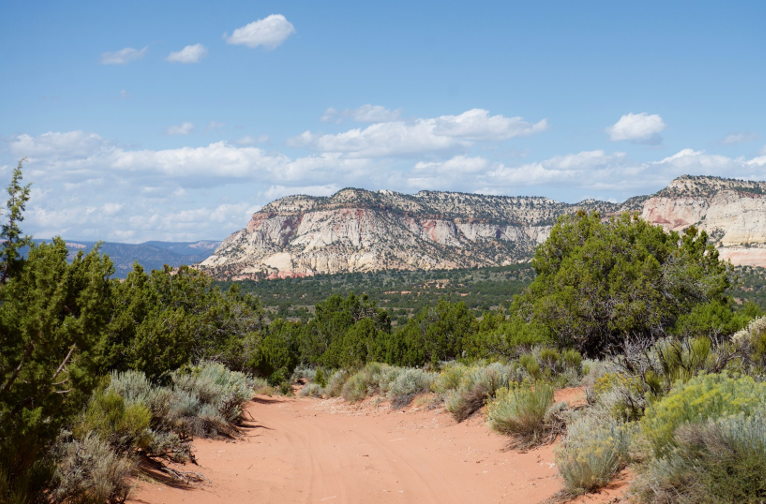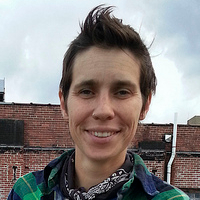Kanab, a small Utah town that’s home to the famous Best Friends Animal Society, took an unconventional path to face down a frac sand mine that threatened the region’s aquifer.
A sign at the north end of Kanab, Utah, proclaims the town of 4,300 to be “The Greatest Earth on Show.”
It’s a rare case of truth in advertising.
Kanab sits just seven miles north of the Arizona state line, at the crossroads of some of the Southwest’s most beautiful places. In every direction a geologic wonderland awaits. To the north is Zion National Park with its breathtaking valley of 2,000-foot-tall rust and white sandstone cliffs. The sweeping expanse of Grand Staircase-Escalante National Monument stretches to the east of town, and just to the south you’ll find the Grand Canyon’s North Rim.
You don’t even need to leave Kanab, which is ringed by the famously red-hued Vermillion Cliffs, to get socked by jaw-dropping beauty.
It’s this landscape that drew Susan Hand to Kanab 25 years ago when she opened Willow Canyon Outdoor to sell gear, maps, books and coffee to local and visiting adventurers. And it’s this landscape and the community’s gateway-to-the-wonderland experience, the economic bedrock of this tourism-dependent town, that she worried would be destroyed by a new industrial project proposed for development 10 miles north of town last year.
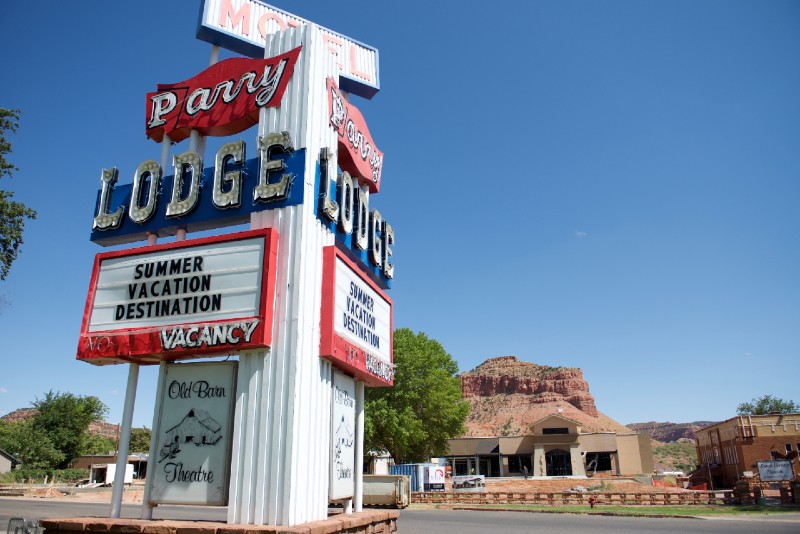
There, a company called Southern Red Sands LLC had announced plans to build a facility to mine and process massive amounts of sand for use by oil and gas companies conducting hydraulic fracturing. The sand is a lesser-known but substantial aspect of the fracking process. Round grains of silica sand serve as a “proppant” to keep underground fissures in the shale open as oil and gas are pumped out. Fracking a single well can require thousands of tons of sand.
“I really wanted to keep an open mind, but the more I learned about the project, the more concerned I got,” Hand told The Revelator when I visited Kanab in September.
She had reason to be worried. The first decade of the fracking boom relied heavily on so-called “frac sand” sourced mostly from Midwest states like Minnesota and Wisconsin, where mining reduced verdant green hills to piles of dust.
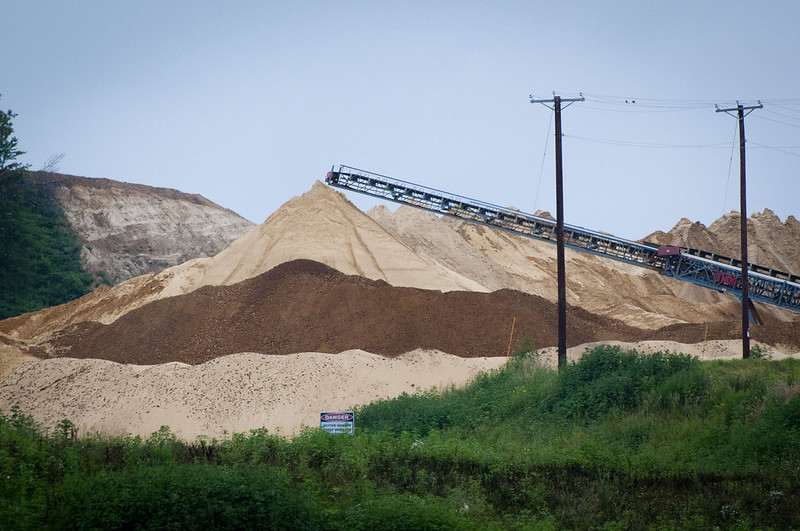
But mining in the Midwest has its limits. Sand is expensive to ship across the country, so as fracking has taken off in Utah, Texas and New Mexico, companies have looked to find more local sources to trim costs.
That’s when the proposed mine in Kanab entered the story.
Southern Red Sands, a two-person start-up backed by Utah real-estate developer Kem Gardner, hoped to establish the region’s next frac sand mine in a scenic area of state-owned lands outside Kanab called Red Knoll.
City and county officials quickly gave their blessing — and a combined 1,200 acre-feet of water rights a year — after only cursory consideration.
But residents became concerned about impacts to scenic beauty, water resources and local businesses. They teamed up to fight back, forming a community group called Keep Kanab Unspoiled.
It was beginning to feel like a familiar story.
The struggle between extractive industries and environmental protection is not a new one in Utah. A fight is still raging nearby over the boundaries of Bears Ears National Monument and Grand Staircase-Escalante, both of which President Trump slashed in order to increase drilling and mining opportunities.
Despite public pushback and some legal challenges, though, the frac sand mine seemed to be cruising toward approval as recently as October. It still needed an environmental impact assessment from the Bureau of Land Management, and the two water transfers needed approval from the state engineer. The project definitely wasn’t a done deal, but in industry-friendly Utah, it had a good shot.
So it may have come as a surprise to a number of residents when Southern Red Sands announced at the beginning of January that it was abandoning the proposed project.
What happened? And are there any lessons that other communities fighting extraction threats can learn?
“Speak out, pull together like-minded neighbors, organize and don’t give up,” Hand told me after hearing the news. “But also, try to be nice.”
Surprisingly, it’s that last bit that may have made a big difference — along with a good hard look at the economics of the endeavor.
The Threats
Von Del Chamberlain is a white-haired, soft-spoken Kanab resident. Born in 1934, he spent his youth exploring the red rock and his career studying the stars. The astronomer and former director of Salt Lake City’s Hansen (now Clark) Planetarium retired to his hometown 15 years ago and hoped to start a public observatory.
He realized that Kanab’s prized dark-night skies would be threatened by a 24-7 mining operation. But that wasn’t even his biggest concern with the project.
“The beauty here is the thing that will sustain this area economically for as far in the future as we can possibly see,” he said.
Opponents like Chamberlain usually cited two big concerns: environmental impacts, particularly the threat to water resources, and the local economy. But in Kanab it’s hard to separate the two.
“It doesn’t matter what kind of an economy you want to develop here,” said Hand. “Even if you have an industrial economy or an extractive economy — if you don’t have water, you’re out.”
The water supply, which draws on underground aquifers, currently supports the town’s tourist-driven economy, ranching, and the county’s biggest employer — Best Friends Animal Society, known worldwide through the Dogtown TV series on the National Geographic Channel. The nonprofit owns a 3,700-acre sanctuary, the country’s largest no-kill animal shelter, and would have been the mine’s closest neighbor.
Best Friends, which employs 400 locals and draws 35,000 out-of-town visitors a year to its sanctuary, came to see the proposed mine as an existential threat. Their property relies on wells, seeps and springs that come from the same aquifer the project’s two wells would tap.
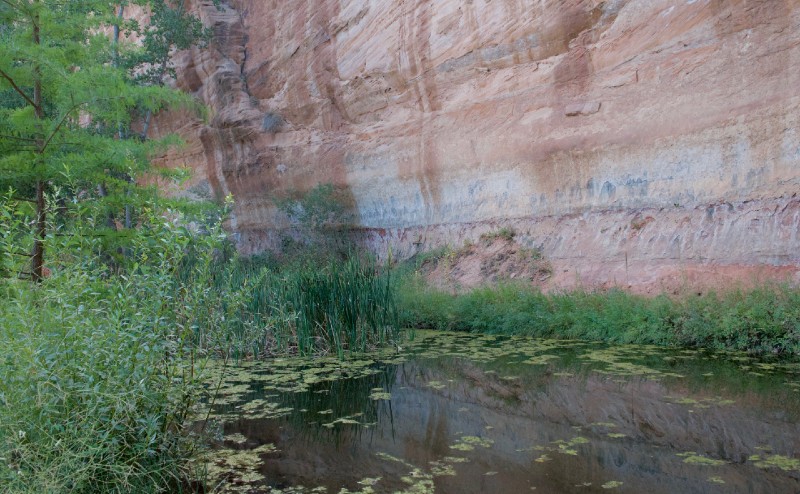
Last July Kanab’s city council approved a 50-year contract for 600 acre-feet a year of water rights for the project and Kane County Water Conservancy District, which oversees water servicing for the unincorporated areas of the county, agreed to provide an additional 600 acre-feet of water. That combined amount equals about 740 gallons per minute, although Southern Red Sands contended it would use only about a third of that.
Many local residents were shocked by the water-rights transfer. A 2016 water needs assessment found that Kane County Water Conservancy District’s reliable supply would be in deficit by 2035. And the district’s executive director, former state representative Mike Noel, has been a vocal advocate for a pricy proposed pipeline to send Lake Powell water to southern Utah communities, including near Kanab, under the premise that the region is already running short on water.
“We knew that it would damage our seeps and our springs, and we weren’t sure yet the full impact besides some drawdown to our groundwater, but we were really concerned,” Bart Battista, an environmental engineer responsible for facilities management at Best Friends’ Kanab sanctuary, told me. “It boggles my mind that the city wasn’t as concerned.”
But documents unearthed by local radio station KUER showed that officials at nearby Zion National Park already were concerned that the project could reduce flows into the East Fork of the Virgin River, which flows through the park, by reducing the amount of water from underground seeps and springs that feed the river.
Wanting to learn more about how the project could affect the region’s water, Best Friends commissioned a study from hydrogeologist Kenneth Kolm of Hydrologic Systems Analysis, a firm that’s completed water studies for other Utah towns.
Kolm found that the mine posed the potential for decline in productivity to wells owned by both Best Friends and the city’s water supply. The project could also decrease flows into nearby Kanab Creek and dry up perennial streams and springs, including one that feeds an area of habitat that’s home to the Kanab ambersnail — currently federally protected as endangered.
The amount of water being withdrawn wasn’t the only issue. The proposed project site and its sandy soil are also vitally important to local hydrology.
“The sand is the first ticket to collecting water,” said Hand. It captures rain and holds it in place long enough for it to sink into the water table and not run off. But the sand is exactly what would be removed from the site, further threatening the region’s water supply.
“I realized for the first time how small and vulnerable our watershed actually is,” she added.
Southern Red Sands hoped to start digging on 640 acres of land around Red Knoll, an aptly name rise of coral-colored rock and sand. The area is managed as part of Utah’s School and International Trust Lands Administration (SITLA), where state-owned property can be leased (often for resource extraction), with revenue being funneled to education.
The operation would have started by bulldozing all the trees, shrubs, grasses and forbs, then scraped up to 30 feet of the earth from the exposed surface. The sand would then be processed — washed with water and chemicals, then dried and sorted — in a facility with up to six 120-foot-tall silos. After that it would be loaded into trucks and hauled out.
A small fraction of the remaining sediment — mostly the fine silts and clays — would be put back on the land. But that change in geology could mean a big change for the aquifer. How big would depend on the scope of the project, though.
In addition to the SITLA land, Southern Red Sands had acquired placer claims — mineral exploration rights — for 12,000 surrounding acres managed by the BLM. And although the company said it planned to mine only 700,000 tons a year from the SITLA property, the facility would have had the capacity and water rights to accommodate much more.
“If they’re building a plant with a capacity of 3 million tons a year, that’s presumably because they expect to be able to produce that,” Dean Baker, a Kanab resident and opponent of the project told me in December. “They may never do that, but you don’t build extra capacity without the idea that you might use it.”
The Resistance
Water issues are paramount in arid Utah, but the mine was likely to come with some other potential problems.
If Southern Red Sands did build out to end of their claims, they’d be within 10 miles of Zion National Park and workers at Best Friends would be looking over their fence line at the operation — not to mention potentially breathing its dust.
Mining, processing and trucking frac sand can release tiny particles of crystalline silica into the air. Inhaling those particles regularly can cause lung disease, including cancer and silicosis, a chronic disease that, like “black lung” for coal miners, can be deadly.
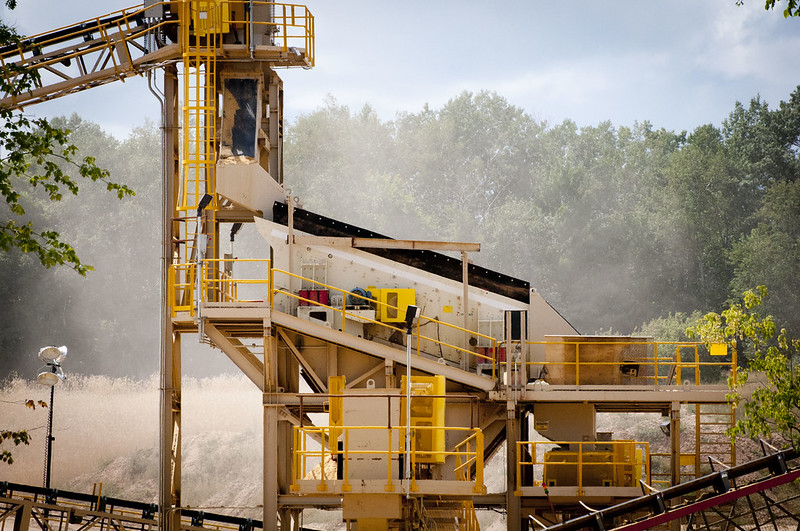
The facility would likely run with lights and noise 24-7, which could be detrimental to wildlife. And adding more diesel-spewing, slow-stopping big rigs hauling 50,000 pounds of sand down the town’s one main road concerned residents, too.
With so much at risk, opponents employed a number of tactics to try to fight the mine.
Keep Kanab Unspoiled held community meetings. They invited Kolm, the geologist who did the independent study, to report his findings, and started an online petition to discourage the company from moving forward.
Best Friends — an established national nonprofit with considerably more financial resources — took the lead role in mounting legal challenges. The organization filed an appeal of a conditional use permit approved by the county and formally objected to the water transfers, which needed to be approved by the state engineer.
But during the fall, Best Friends decided to shift tactics. Lawsuits could just lead to years of legal battles, something beyond the organization’s longstanding mission.
“We might alienate our donors and members,” Battista explained. “The appeal of Best Friends crosses party boundaries — animal welfare is something everybody can support.” Apparently environmental action is not.
They decided the best approach was to sit down and talk with the company and its backers.
Battista couldn’t disclose details of the negotiations — which went on for months — but on Jan. 9 Best Friends and Southern Red Sands released a joint statement saying that the company “had decided not to pursue its business ventures in Kane County.”
The members of Keep Kanab Unspoiled were elated by the news.
“It’s so heartening how so many people from our community came together to amplify a voice that is seldom acknowledged by our elected representatives and institutions,” Hand tells me. “I’m relieved that an area I love won’t be sacrificed on the altar of fossil fuel consumption. I’m grateful that this threat to our travel and tourism economy is diminished.”
It would be comforting to think that the driving force behind the decision boiled down to preserving the scenic beauty or the region’s groundwater resources, but it’s more likely it had to do with money.
“Economics played some role,” Battista said. “The market for frac sand has changed and [Best Friends] had financial viability assessments of the project to show that the mine wouldn’t be a good idea. Economically it just didn’t make sense to any of us. I think that our studies corroborated that.”
This was a main talking point of Keep Kanab Unspoiled, bolstered by research done by Baker, who also happens to be an economist and cofounder of the Center for Economic and Policy Research.
The frac sand industry — and the larger fracking industry — is volatile. The number of rigs drilling for oil tends to fall when prices get low. Rigs plunged with falling prices from 2014 to 2016 and last year saw record declines in rig numbers. In addition, fracking costs more than traditional drilling — and the industry has also been overspending to keep the fracking boom from going bust.
A research organization in Norway found that the amount of money being spent to drill for oil by 40 U.S. shale oil companies outpaced the money being made by selling that oil. That deficit cost companies almost $5 billion in just the first quarter of 2019, DeSmog reported in August.
It’s a scenario that’s happened before.
With oil prices now around $60 a barrel, the industry is hanging on. If prices dip much lower, it could be trouble. A decade into the fracking frenzy, investors are worried that the best spots have been drilled and many debts won’t be paid.
There’s even more uncertainty when it comes to producing and selling the sand. Companies used to rely almost exclusively on Midwest sand, but now more areas are getting in on the game.
The consequences of failures in the fracking business model are real.
Falling oil prices and a shifting market for frac sand recently took down Emerge Energy Services — owner of eight frac sand facilities in Wisconsin — which filed for bankruptcy last summer and left behind unsafe levels of arsenic and heavy metal contamination for the community to clean up.
That’s a scenario that Baker worried could happen in Kanab. Southern Red Sands said their intended market was in Utah’s Uintah Basin 350 miles north, but a new frac sand mine just opened in the basin. “It’s almost inconceivable they’d be able to compete with them because the biggest cost with frac sand is the shipping,” said Baker. “There are some operations in the San Juan basin [in New Mexico and Colorado] but it’s not clear to me that they could beat those out either.”
Even though economics played a role in halting the project, he believes community efforts were important, too.
“The fact they faced serious legal obstacles at every step in their path had to be a factor,” he said. “It is a nice, and unfortunately rare, victory for the environment.”
Best Friends worked to ensure the hard-earned victory wasn’t short-lived, either. It also purchased Southern Red Sands’ 12,000 acres of mineral rights.
“We want to make sure that no one else comes in here in two years if the market’s better and tries to put in another sand mine, we just don’t think that it’s the right thing for this area,” says Battista. “We want to make sure that in perpetuity, there’s not a threat to the sanctuary.”
As for Hand, she’s now looking at the bigger picture. She saw the fight over frac sand in Kanab as a microcosm of the global fight over fossil fuels and climate change.
“While we can embrace a sense of triumph, it’s likely to be brief,” she says. “When it comes to protecting wild places and using our resources carefully, our work will never be done. The next development project is already bubbling. I do feel more hopeful for each success, but climate change marches on.”


